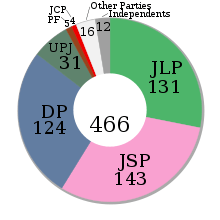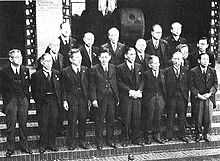Katayama Cabinet



The Katayama Cabinet (片山内閣 Katayama naikaku) governed Japan under the leadership of Prime Minister Tetsu Katayama from May 1947 to March 1948. It was the first cabinet under the postwar constitution.
The Japan Socialist Party (Nihon Shakaitō, JSP) had emerged as strongest party from both the 23rd lower house election and the 1st upper house election. However, the formation of a coalition proved difficult as any majority coalition would involve at least two of the three largest parties. While the Socialists offered the conservative Japan Liberal Party (Nihon Jiyūtō, JLP) of incumbent prime minister Shigeru Yoshida a grand coalition, Yoshida refused active participation in the government. Under the new constitution, the prime minister was no longer selected by the Emperor, but elected by the Diet, "before the conduct of any other business" – and the Socialists pushed for an early vote to prevent the other two major parties from excluding them from a ruling coalition: on May 23, Socialist Tetsu Katayama was elected almost unopposed (420 votes of 426 present in the House of Representatives, 205 of 207 in the House of Councillors) while the coalition negotiations were still in progress. When Katayama formally became prime minister on May 24 after his ceremonial investiture by the Emperor, he technically held all ministerial posts – a so-called "one-man cabinet" (hitori naikaku, 一人内閣). The JLP still refused cooperation, and the JSP eventually agreed on a coalition with the Democratic Party (Minshutō) and the People's Cooperative Party (Kokumin Kyōdōtō). Together, the three parties held a solid majority in the HR, and were able to control the HC given the fact that the largest group there, the Ryokufūkai formed by independents, was willing to support the government. The other cabinet members were eventually appointed on June 1. The cabinet initially consisted of seven Socialists (including the prime minister), eight Democrats, two Cooperativists and one Ryokufūkai member.
After conflicts over price controls and taxes, the left wing of the Socialist Party threatened to block the budget for fiscal 1948 (begins in April), and in February 1948, Katayama resigned. Deputy prime minister Hitoshi Ashida was elected on February 21 to succeed him, the Katayama Cabinet remained in office until his investiture on March 10. The three-party coalition of Socialists, Democrats and Cooperativists continued under Democrat Ashida, however the Ashida Cabinet would be engulfed by the largest corruption scandal of the occupation period and last even shorter.
| Portfolio | Minister | Party | Diet membership |
|---|---|---|---|
| Prime Minister | Tetsu Katayama | JSP | HR, Kanagawa 3 |
| Deputy Prime Minister Foreign Affairs | Hitoshi Ashida (from 1 June 1947) | DPJ | HR, Kyōto 2 |
| Internal Affairs (until abolition on 31 December 1947) Construction (from 1 January 1948) | Kozaemon Kimura (from 1 June 1947) | DPJ | HR, Shimane At-large |
| Finance | Shōtarō Yano (from 1 June to 25 June 1947) | DPJ | HR, Kagawa 2 |
| Takeo Kurusu (from 25 June 1947) | Ryokufūkai/JLP | HC, Yamaguchi | |
| Justice (until abolition on 15 February 1948) Justice(from 15 February 1948) |
Yoshio Suzuki (from 1 June 1947) | JSP | HR, Fukushima 2 |
| Education | Tatsuo Morito (from 1 June 1947) | JSP | HR, Hiroshima 3 |
| Health and Welfare | Sadayoshi Hitotsumatsu (from 1 June 1947) | DPJ | HR, Osaka 1 |
| Agriculture and Forestry | Rikizō Hirano (from 1 June to 4 November 1947) | JSP | HR, Yamanashi At-large |
| Tetsu Katayama (acting) | JSP | HR, Kanagawa 3 | |
| Kanae Hatano (from 13 December 1947) | JSP | HC, Fukuoka | |
| Commerce and Industry | Chōzaburō Mizutani (from 1 June 1947) | JSP | HR, Kyōto 1 |
| Transport | Gizō Tomabechi (from 1 June to 4 December 1947) | DPJ | HR, Aomori 1 |
| Tokutarō Kitamura (from 4 December 1947) | DPJ | HR, Nagasaki 2 | |
| Communications | Takeo Miki (from 1 June 1947) | PCP | HR, Tokushima At-large |
| Without portfolio Labour (from 1 September 1947) | Mitsusuke Yonekubo (from 1 June 1947) | JSP | HR, Hyōgo 2 |
| Economic Stability Prices | Hiroo Wada (from 1 June 1947) | Ryokufūkai | HC, National |
| Demobilization (until 15 October 1947) Without portfolio Reparations (from 1 Februar 1948) |
Junzō Sasamori (from 1 June 1947) | PCP | HR, Aomori 2 |
| Administrative oversight | Takao Saitō (from 1 June 1947) | DPJ | HR, Hyōgo 5 |
| Without portfolio Local finance (from 7 January 1948) | Giichi Takeda (from 1 June 1947) | DPJ | HR, Ishikawa 1 |
| Without portfolio Chief Cabinet Secretary (not automatically a minister of state yet) |
Suehiro Nishio (from 1 June 1947) | JSP | HR, Osaka 2 |
| Without portfolio | Heima Hayashi (from 1 June 1947) | DPJ | HR, Fukushima 2 |
Other positions
| Deputy Chief Cabinet Secretaries | Eki Sone | JSP | – |
| Sueichi Takigawa | – | – | |
| Legislation Bureau | Tatsuo Satō | – | – |
References
- Kantei, Japanese Cabinet: Katayama Cabinet (Japanese)
- Kohno, Masaru (1997): Japan’s Postwar Party Politics. Princeton, pp. 49–67, Chapter 4: Coalition building under the pre-1955 multiparty system.
| ||||||